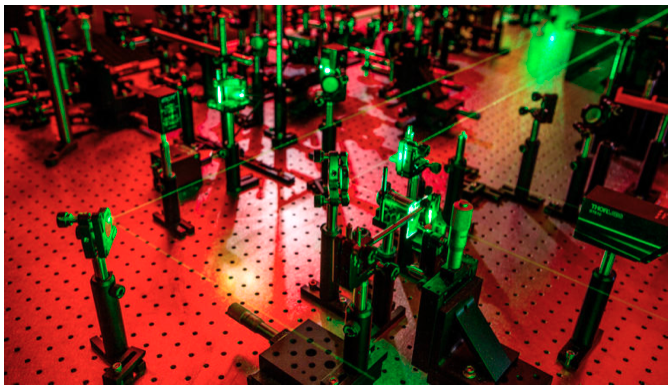This laser ultrasonic setup allows the team to observe vibrations of microscale granular crystals. (Credit: Dennis Wise/University of Washington)
On the microscale, granular materials interact in remarkably complex ways. That complexity makes them one of the least understood forms of matter.
Now scientists want to figure out how to take advantage of those interactions to design impact-absorbing materials. For example, these new materials might minimize vibrations in vehicles, better protect military convoys, or potentially make buildings safer during an earthquake.
As a first step, researchers have analyzed particle vibrations in very small 2D granular crystals. The results could ultimately help predict how these tiny arrays of particles behave as forces are applied.
‘Build better sandbags’
One of the more interesting characteristics of granular materials is that they are dynamically responsive—when you hit them harder, they react differently.
“You can take a pencil and push it through a sandbag, but at the same time it can stop a bullet,” says Nicholas Boechler, assistant professor of mechanical engineering at the University of Washington and senior author of the paper published in Physical Review Letters. “So in some ways what we’re trying to do is build better sandbags in an informed way.
Boechler and colleagues discovered that microscale granular crystals—made of spheres that are smaller than a human blood cell—exhibit significantly different physical phenomena than granular materials with larger particles. Adhesive forces play a more important role, for instance. The array of tiny particles also resonates in complex patterns as forces are applied, and they knock into each other, including combinations of up-and-down, horizontal, and rotational motion.
“This material has properties that we wouldn’t normally see in a solid material like glass or metal,” says Morgan Hiraiwa, lead author and mechanical engineering doctoral student. “You can think of it as all these different knobs we can turn to get the material to do what we want.”
Laser-generated waves
The team manufactured the 2D ordered layer of micron-sized glass spheres through self-assembly—meaning the millions of particles assemble themselves into a larger functional unit under the right conditions.
Building large amounts of material composed of microscopic particles, such as a panel for a vehicle, is impractical using conventional manufacturing techniques because of the amount of time it would take, Boechler says. Self-assembly offers a scalable, faster, and less expensive way to manufacture microstructured materials.
The team then used laser ultrasonic techniques to observe the dynamics between microscale granular particles as they interact. That involves sending a laser-generated acoustic wave through the crystal and using a separate laser to pick up very small vibrations of the microscopic particles.
Researchers have studied the dynamics of granular crystals with large particles, but this is the first time such complex dynamics have been observed and analyzed in microscale crystals, which have advantages over their larger counterparts. Their small size makes it easier to integrate them into coatings or other materials, and they also resonate at higher frequencies, making them potentially useful for signal processing and other applications.
“The larger systems are really nice for modeling, but can be difficult to integrate into many potential products,” Boechler says.
Spacecraft coating
So far, the team has conducted its experiments using low-amplitude waves. Next steps include exploring high-amplitude, nonlinear regimes in 3D crystals—in which the granular particles are moving more vigorously and even more interesting dynamics may occur.
“Ultimately, the goal is to use this knowledge to start designing materials with new properties,” Boechler says. “For instance, if you could design a coating that has unique impact-absorbing capabilities, it could have applications ranging from spacecraft micro-meteorite shielding to improved bulletproof vests.”
The National Science Foundation, the US Army Research Office, and the University of Washington Royalty Research Foundation funded the work. Additional researchers from the University of Washington and the Massachusetts Institute of Technology took part in the study.
Source: University of Washington , Original Study, Posted by Jennifer Langston-Washington, CC by 4.0 International

